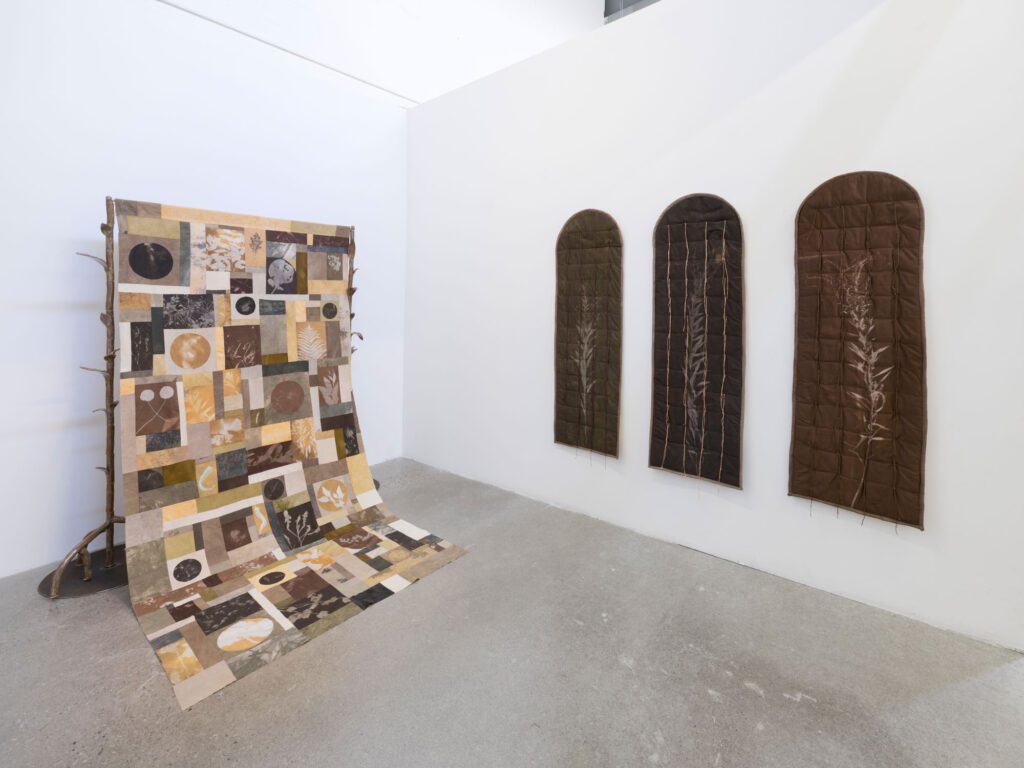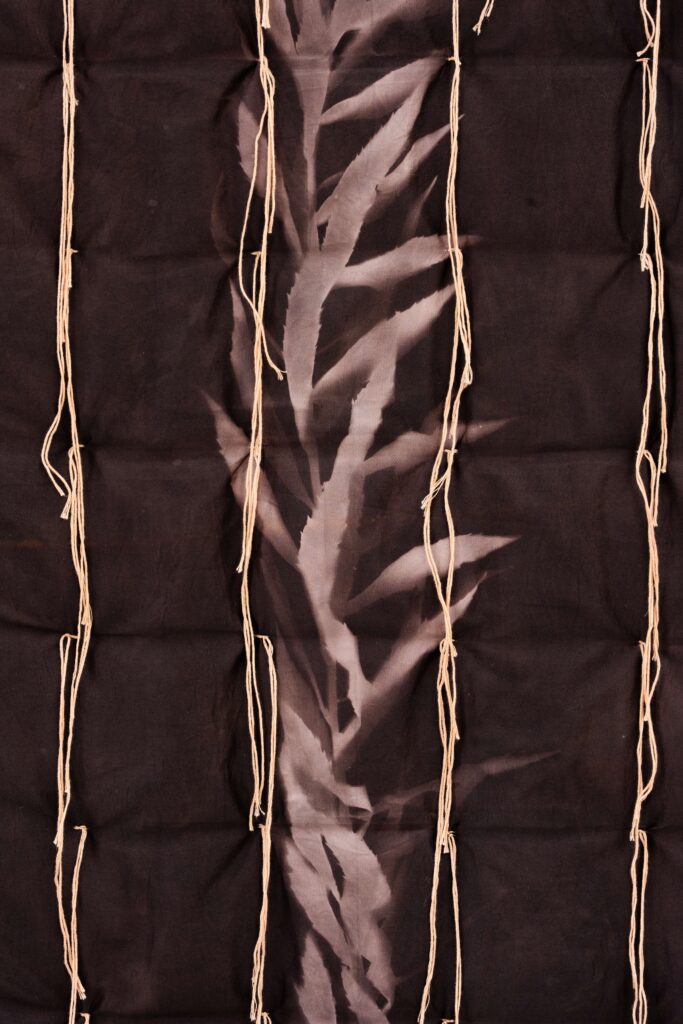Cultivation, Continuum, and Craft: In Conversation with Holly Chang
20 August 2025By Lodoe Laura

This spring, I met with artist Holly Chang to talk about her newest work, Garden into Infinity (2025). At the time, there was still a slight chill in the air, though our shared landscape in Toronto’s west end was starting to shift into a more green and verdant one.
Holly says she knew me when we were both undergraduate students interested in photography, though the first time I remember meeting her was years later, at a natural dyeing class she led at OCAD University. In the class, she taught us how organic materials could colour and tone fabric and fibre. It was a magical and witchy experience—standing over boiling cauldrons of water filled with plants and herbs.
For her newest work, Chang employed the slow manual processes of gardening, indexing, and sewing as a way to process grief during a time of loss. The project, created in collaboration with the land that she maintained at her friend’s backyard garden in the west end of Toronto in the summer of 2024, consists of over 500 cyanotypes on fabric that preserve moments of fauna flourishing in the garden. According to Chang, the garden became a reflection of lifecycles, almost a portal from which to observe them.
After her time in the garden came to a close, Chang transformed the resulting jewel-blue cyanotypes into ghostly earth-toned images, and quilted them into patchwork mosaics, reimagining her grief into something soft and comforting for herself and the viewers.
In my conversation with the artist, we discuss her connection to plant cultivation, working in photography and its associated legacies, and the meditative and tactile nature of her working process.
Lodoe Laura: Holly, I’m so happy that we’re able to talk about your new work, Garden into Infinity. I think the obvious place to start is the origins of the work—how did the project come about?
Holly Chang: This started because I became totally obsessed and consumed with gardening. I had always loved the idea of gardening but I never had the space of my own to create one. Last summer, my friend Sarah Bodri put out a call on Instagram to see if anyone would be interested in partnering on her garden, so I reached out. That was the catalyst in our summer garden last year, we called it our “co-parenting project” and worked once or twice a week on it. Gardening had always been in the back of my mind—I grew up watching my aunt and Popo (grandmother) garden. It was always a special and magical space for me and my sister, we would spend hours playing in their yard. Last year when I started the gardening project with Sarah, I was processing a lot of difficult emotions and my time gardening with her became like a meditation. I love the idea of repetition, and the movement of my body in the garden I found to be a relief. Within this process of gardening, I became interested in the documentation of what was growing—either planted by us or what arrived on its own. I started to observe different patterns and the garden became a portal into the cycles of my own life. Plants living and dying simultaneously, over and over—the rhythms and materials constantly being recycled into infinity, again and again, in the garden.

LL: I love this idea of cycles. What did you grow? Is there any connection to the gardening you saw your aunt and Popo doing growing up?
HC: My Gung gung (grandfather) was really the catalyst for my family garden—after he passed away, it was something my aunt and Popo did together. I saw the way that they cared for that space collectively, and how it brought them closer together. It’s a beautiful thing for Sarah and I to share—that the garden is a collective space for the two of us to collaborate on. There aren’t specific plants that I carry forward in my garden, but more of the spirit of the act and what it means to share something together in less tangible ways.
LL: At what point did you start thinking about documenting your garden through cyanotypes?
HC: My artistic work has always been grounded in photography—as my practice has evolved over the years, I’ve become less interested in the actual act of taking photos, but I’ve always been interested in images. Cyanotypes felt like an obvious step for me in my practice; as I recently moved away from photography and into textiles, cyanotypes provided me with the possibility of printing images directly onto fabric. Cyanotypes are very accessible and easy to produce, they also have a history and connection to botany and the documentation of nature. It came naturally to me to produce images as I gardened since the process of making cyanotypes is so passive, it felt like there was an inherent connection between the two. I would pull things out of the ground or cut them down, and I would lay a fabric sheet out and quickly capture an image before the plant rapidly decayed—especially in the summer heat, the plants would wither fast. Since this was also my first year gardening, I felt protective and sentimental about what was growing and wanted a way to remember those plants, even the weeds.
LL: The cyanotype is a very early form of photography. There is something so immediate about the image made from an object touching a light-sensitive material.
HC: Cyanotypes are really special, but at the same time, they have strong ties to British imperialism and colonialism, which is something I want to explore more. Anna Atkins was an arbiter of cyanotypes in the mid-1800s and she helped to popularize the medium—she was one of the first people to publish a book with photographic images in 1843. At the same time, Anna Atkins was married to John Polly Atkins, the son of Alderman John Atkins, who was a West Indian merchant and slave owner. Atkins and her family profited from several plantations in Jamaica and the wealth amassed from the colonization and this enslavement of people in the West Indies helped to finance her artistic practice. For me, it’s hard not to look at the history attached to cyanotypes and I am really interested in better understanding how to situate my work within this. In some ways, the practice feels extractive to me—but that’s why it was important to document plants that were already being removed either to be eaten or composted.
LL: This is so interesting to know, especially given your family’s connection to Jamaica. Yes, the medium is inextricably linked with colonial projects in many ways, and cataloguing in this specific way attempts to make something ephemeral long-lasting. To me, it seems like there is a pursuit to stop time, to control the natural world, which also intersects ideas around permanence. How are you thinking about permanence in this practice?
HC: That is such a great observation—permanence, to me at least in this project, is connected to my attachment with the plants. Because this is a garden that I have personally cultivated, I’ve seen the entire life of these organisms, from seeds to fully developed plants, to an eventual decay. There is a huge attachment and pride that comes with creating a garden. The cyanotypes, in part, were about trying to save and remember these beings. We would grow the same plants over and over again, like tomatoes, but every plant is unique and never the same.

LL: It seems to me that the land, the plants, and the sun are your collaborators in this work. Do you see it this way?
HC: Absolutely—I think it’s important to acknowledge the greater forces that surround us and that they have autonomy. We coexist with these organisms but often they go unnoticed. This project became an opportunity to learn more about plant cultivation and understand better the plants that grow all around us, and their importance as active contributors to our ecosystems and food systems.
LL: Cyanotypes typically come out in an indigo blue hue, but you processed the prints to become these more muted earth-tones. The browns and beiges of the images seem so appropriate for the prints, it’s almost impossible for me to imagine that they were once blue. Talk me through the choice to process the prints in this way.
HC: I have always loved cyanotypes but in my experience, have seen them most commonly used in their initial form which was blue. I felt compelled by the process but not necessarily about the aesthetics and the connotations attached to it as a blue image. When I was thinking about this project, I did some research to find out whether or not I could shift the tones of the image which I was able to accomplish. I felt that the process of toning and dyeing was strongly connected to my pre-existing practice with natural dyeing that it came as an instinctive step. I like the ambiguity of the cyanotype being a colour other than blue because it makes the image less obvious and again, removing some of the connotations that would be attached to it if it was still blue.
LL: What was your process of deconstruction, assemblage and quilting in this work?
HC: After accumulating all the images, I had some idea of how I wanted to reassemble them. For the larger piece, I liked the idea of it resembling what I call a ‘scrapbook:’ that plants from every part of the gardening season could coexist together, even if they might not have grown at the same time. For the arched pieces, after seeing those particular weeds growing wild in the yard, I knew I wanted to document them as long, skinny images. I intentionally cut the cyanotype fabric sheets so that it would fit those plants. But for the most part, it was intuitive in how I assembled them. I also wasn’t sure how the images would look after I toned them, so I had a better idea, once I had shifted the colours, how I wanted to assemble them.

LL: Gardening, dyeing, sewing, and ceramics—other mediums you work in—are all very tactile projects. They are slow practices that take concentration and physical effort and technique. It seems like you are drawn to these slower processes. Is this true?
HC: I have a deep obsession with craft. I have always liked working with my hands but this became amplified during my MA in 2019-21 (during the pandemic). My artistic background was primarily in photography, but I became disillusioned with the practice the longer I continued. I picked up photography when I was nine-years-old and continued the practice independently through my teens and as a university student. I felt like two things were happening during my degree, one was that I was hitting my limit with how far I could push my practice, and two, a lot of photography was grounded in working on the computer. This obviously became amplified during the pandemic when everything was virtual and I made a decision that I couldn’t continue my practice in the same way, I just couldn’t look at the computer anymore.
I love touching things, so I decided to pivot into textiles which felt accessible at the time. I took a sewing class in highschool, so I had a basic level of competency and was able to close the skills gap through reading books and watching YouTube (aka YouTube university). I started naturally dyeing around the same time which I also learned through books and videos. Textiles and dyeing are very prevalent in this particular project, but I honestly have an interest in almost all craft mediums. It is such a creative boost to be able to create with my hands, and I love process, which is probably why I chose more challenging projects that have a lot of moving elements, such as this project. Craft inherently makes me work more slowly, intentionally—you can’t rush anything. In photography, the entire premise is about working rapidly, working quickly to capture a moment. I felt drained by that way of working and thinking. I occasionally indulge in image making but only when I feel compelled, when it doesn’t feel like a chore and more like a treat. Again, I still love photography but I like the challenge of making images more slowly—cyanotypes are slow with the exposures taking anywhere from 5 to 20 minutes. It is a treat to watch a sheet transform from blank to the impression of the object, and then to wash it with my hands. My hands were completely blue all summer last year and I even stained my shoes. Overall, I am just more drawn to physical things and the transformation of images.
LL: It’s spring now—a new cycle in the garden. What is your relationship with the garden now?
HC: We are just getting the garden started this year, we have planted some seeds and seedlings. It is such a process of trial and error—I tried growing some herbs from seeds and nothing happened. That is just the nature of things, you cannot control anything in the garden, you can only work to cultivate and care for it really. As much as we have a “plan” for what we want to grow, it’s all about learning. Every plant is different, every season is different and things that did well last year might not react the same this year. It is so much about trying to carefully observe what’s happening and respond. The pots where I wanted to grow herbs, we will have to try again with something else. We are also experimenting with some new veggies this year that we didn’t try last year, which is so exciting!
Feature Image: (Detail) Holly Chang, Garden into Infinity, Mother and Scrapbook, 2024. Photo by Darren Rigo, courtesy of the artist and Blouin Division.



